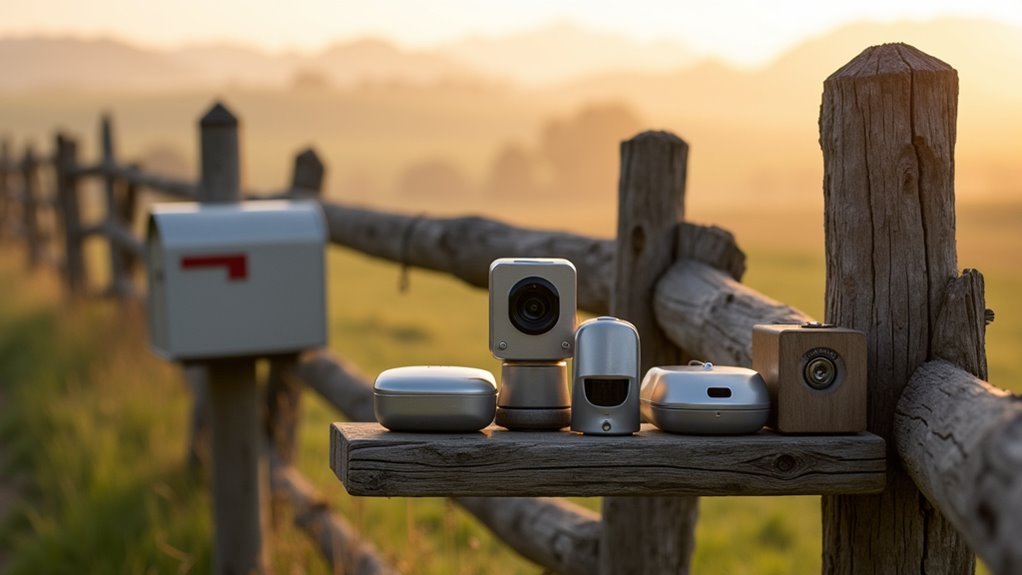You’re likely spending money on security features that won’t actually protect your home if you’ve chosen the wrong motion sensors. The difference between an effective system and a useless one often comes down to three specific sensor types, each with distinct advantages that most homeowners don’t understand. Your choice will determine whether intruders trigger immediate alerts or slip past undetected, making this decision more critical than you might expect.
Passive Infrared (PIR) Motion Sensors for Heat Detection

PIR motion sensors form the backbone of most home security systems by detecting the infrared radiation naturally emitted by warm objects like human bodies and pets.
These passive infrared sensors detect motion through pyroelectric technology that converts temperature changes into electrical signals, providing reliable security features for your property.
You’ll appreciate their impressive detection range of 20-30 feet, which covers large areas effectively. Their exceptional battery life often exceeds one year, making them perfect for wireless installation options.
With 20-30 foot detection range and year-long battery life, PIR sensors deliver expansive coverage and reliable wireless performance.
PIR sensors reduce false alarms by focusing specifically on heat signatures rather than general movement.
When integrated into smart home security networks, they’ll automatically trigger lights or alarms, enhancing both safety and energy efficiency throughout your home.
Microwave Motion Sensors for Large Area Coverage
While PIR sensors excel at heat detection, microwave motion sensors take home security coverage to the next level by emitting microwave pulses in the 1 to 10 GHz range that penetrate solid objects like walls and doors.
These sensors provide large area coverage with exceptional long-range capabilities, making them perfect for monitoring challenging environments. Their advanced technology delivers high accuracy when they detect movement by bouncing pulses off moving objects, helping reduce false alarms considerably.
| Feature | Benefit | Impact |
|---|---|---|
| Wall penetration | Monitor blind spots | Complete security |
| Temperature immunity | Reliable detection | Peace of mind |
| Smart devices integration | Remote control | Ultimate convenience |
You’ll find microwave motion sensors more sensitive than PIR alternatives, though the installation process requires higher investment. Their compatibility with smart devices makes them ideal for thorough home security systems.
Dual-Technology Motion Sensors for Enhanced Accuracy

When you need maximum accuracy with minimal false alarms, dual-technology motion sensors deliver unmatched reliability by combining both PIR heat detection and microwave pulse technology in a single device.
These advanced security systems require both passive infrared and microwave detection methods to trigger simultaneously, dramatically reducing false alarms caused by pets, temperature fluctuations, or environmental interference.
You’ll appreciate the adjustable sensitivity settings that let you customize detection thresholds for your specific environment.
The microwave detection component identifies movement through solid objects while PIR monitors heat changes, ensuring thorough coverage.
When integrated with smart home systems, dual-technology motion sensors provide real-time alerts and enable automated responses like activating cameras or lights.
This enhanced reliability makes them ideal for protecting your home’s most critical areas.
Frequently Asked Questions
What Type of Motion Sensor Is Best?
You’ll want PIR sensors for most homes since they’re reliable and affordable. If you’ve got larger areas to cover, consider active microwave sensors. For basic door and window monitoring, contact sensors work perfectly fine.
Which Security Camera Has the Best Motion Detection?
You’ll find Google Nest cameras offer the best motion detection through AI-powered technology that accurately distinguishes between different movement types. They’ve mastered reducing false alarms while maintaining precise threat identification capabilities.
What Are Two Drawbacks of Using Motion Sensors?
You’ll face false alarms from pets or environmental changes that require costlier advanced models. You’ll also need regular battery maintenance and replacements, creating ongoing expenses and inconvenience for your home security system.
What Is the Difference Between a Motion Sensor and a Motion Detector?
You’ll find motion sensors specifically detect infrared radiation changes, while motion detectors encompass broader technologies like cameras and radar. Though they’re often used interchangeably, motion detectors include more detection methods.





Leave a Reply